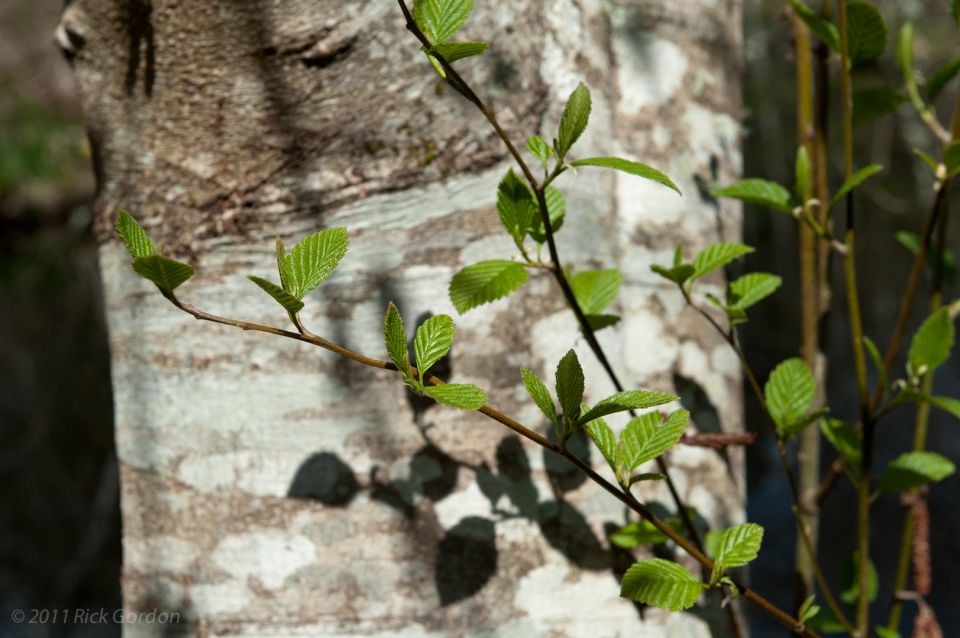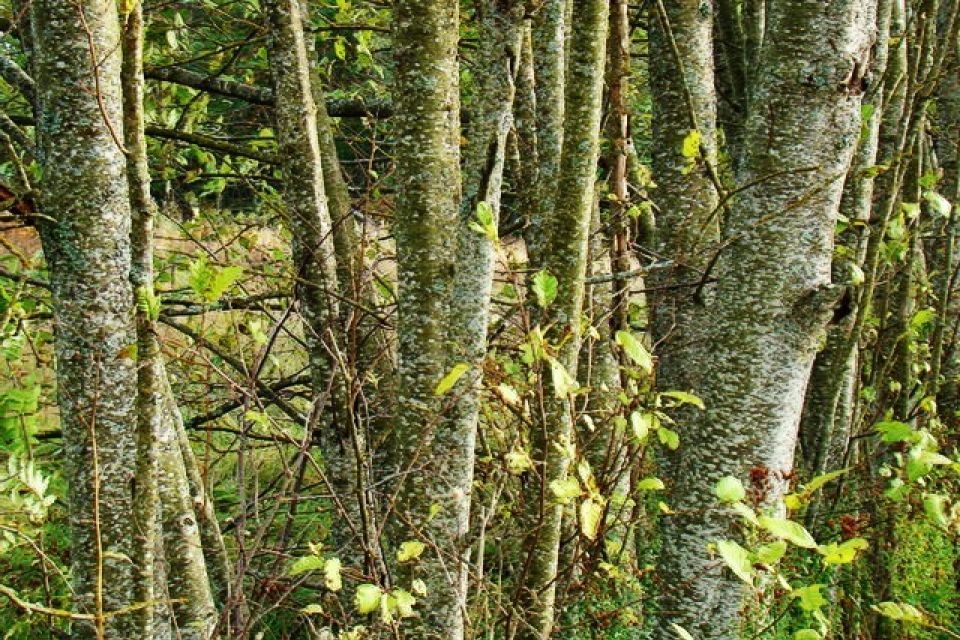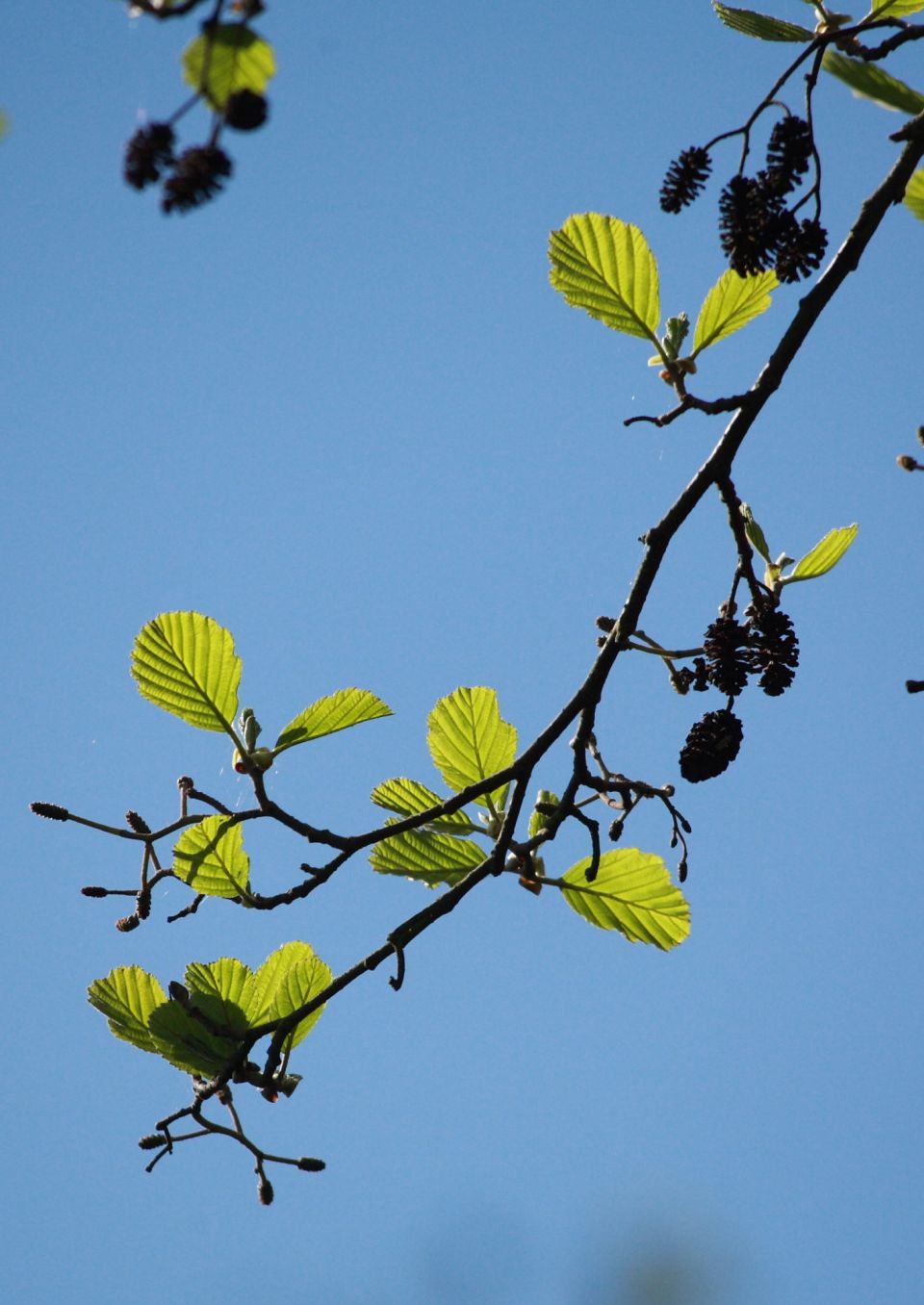Intreeducing: the Alder – a super hero tree pioneer!

The Alder is a pillar of the tree community, supporting the survival of other species, and providing shelter to animals and humans too.
This unassuming water-loving tree punches well above its weight, although many people may be unaware of it. If you see water, an Alder may be close by, and similarly if you spot an Alder, you can safely guess that there’ll be water in its vicinity. It’s many super powers range from fertilising barren land to being a rock god. It arrived on our shores as far back as 8000 BC and thrived in parts other tree species couldn’t survive in. This is a super hero tree pioneer.
How to spot it:
The tree has a slender conical shape, grows to about 20 metres high, and lives for around 60 years. There are often two or three main trunks growing together and young twigs and buds are sticky to the touch. Purple or grey leaf buds turn into leathery, long (3 to 9 cm to be exact) dark green leaves, with a serrated edge and shaped a bit like the head of a tennis racket. The tips are rounded, and in autumn these leaves stay green for longer than most other deciduous trees. The alder is also the only native deciduous tree to have tiny cones.
Alder is monoecious, which means that both male and female flowers are found on the same tree. They take the form of catkins that appear in early spring, between February and April, usually before the leaves. Male catkins are yellow and pendulous, dangling from the branches at about 2 to 6 cm long. Female catkins are green, small and rounded, and are grouped in numbers of three to eight on each stalk. After wind pollination the female catkins gradually turn into brown and woody fruit by autumn, taking the form of unmistakable tiny cones. When ready they open and disperse their seeds on the currents of wind and water. The clever seeds, or nutlets, are flat and waxy and have two corky wings containing air bubbles, which allows them to float and to be carried away by water. The cones remain on the tree during the winter, long after the seeds are gone, and if you spot them, you’ve found an alder!

The superhero tree
Alder is a member of the Birch family and a distant relation of the Elm. It is a pioneer species, meaning it’s one of the few species able to populate an area that’s too barren for most others. It has a rare super power which not only helps it to do this, but also paves the way for other species of trees and plants to grow where they couldn’t before. Alder is a nitrogen fixing tree. This means it has a symbiotic relationship with a friendly bacterium called Frankia alni. The bacteria are hosted by the Alder’s root system, forming large knots on root nodules, and then they go about converting airborne nitrogen in to soil-based nitrates, which nourish the Alder. In return for this natural soil fertilizer the Alder feeds the bacteria with photosynthesised sugars that it makes using energy from the sun in its leaves. It’s a win-win situation for everyone.
Alder’s ability to fertilize even the poorest soils has been used for millennia; there is even evidence that the Incas planted Alder for this very purpose in their terraced farmland on the sides of the Andes Mountains. The tree loves to keep its roots, or feet, wet, following rivers, lakes and damp cool areas. You may also see it in hedgerows, and on marshy soil it can grow up as an Alder Carr, a dense thicket of smallish trees.
The tree sustains wildlife in a pretty genius way. The roots of the alder can help to stabilise the riverbanks and lake sides and prevent the soil from being washed away. This provides different habitats and supports a diversity of life. For example, the roots can shelter fish from predators and form cosy nest sites for otters. Alder leaves provide food for invertebrates such as the larvae of caddis flies, stoneflies and water beetles. These, in turn, are preyed upon by fish including salmon and brown trout.

Alder is not only useful to wildlife but to people too. Amazingly, the soft and porous wood of Common Alder amazingly doesn’t rot under water - in fact, it actually hardens when soaked. That’s why our ancestors used it to shore-up canals and riverbanks, in the construction of boats, sluice gates and water pipes. It’s no surprise then that much of Venice is built on foundations of alder trunks.
Alder coppices well and the wood makes excellent charcoal and gunpowder, it’s also good for smoking meat and fish. Mind you, the coppicing of Alder and other trees by humans has been going on for much longer than written records suggest. There is a Neolithic wooden pathway called The Sweet Track, dating from about 3900BC and preserved in the peat of the Somerset levels. It’s a sophisticated structure built to provide dry footing over marshland and is made out of various coppiced poles including Alder.
Alder used to be the preferred wood to make clogs, and it was said that a few alder leaves placed in the shoes before a long journey would cool the feet and prevent swelling. It is thought that the female woodworm lays eggs in alder in preference to other wood. Traditionally, alder branches were cut and placed in cupboards to deter woodworm from laying eggs in them.
Alder has a mystical side too, going further back it was sacred to the Druids and Picts. When cut, the pale wood turns a deep orange, giving the impression that it’s bleeding. As such, many people feared alder trees and the Irish thought it was unlucky to pass one on a journey. Often growing in spooky mysterious places like wet swampy woods, it became associated with those that may inhabit such locations. The green dye from the flowers was used to colour and camouflage the clothes of outlaws like Robin Hood and possibly the clothes of Faeries too.
These days Alder wood is used to make more prosaic things like timber veneers, pulp and plywood. The tree’s nitrogen fixing ability is used to improve soil fertility on former industrial wasteland and brownfield sites and they are also used in flood mitigation.
But that’s not all there is to Alder. Not satisfied with being a superhero to wildlife and the environment and super useful to humans, Alder is also musically talented and is a bit of a rocker at heart. Since humans began to make music we have cut flutes out of Alder branches, and Alder wood is still used today to make the bodies of top end Fender electric guitars such as the Stratocaster. The beautiful sound it creates cements its status as a rock god, another funky talent to add to the list.
The alders’ heel
For all its strengths, there is a threat to the alder. Some in the UK have been infected by a type of fungus, Phytophthora alni. Diseases caused by Phytophthora are quite common on broadleaf tree species, but it was thought to be uncommon on alder until the discovery of a new hybrid strain, which causes root rot and stem lesions. The disease is now considered to be one of the most damaging diseases of natural ecosystems in Europe for the last twenty years.
Despite this, the alder remains a multitalented tree, or even a renaissance tree! It fertilises the land, giving refuge to fellow creatures, providing wood with magical properties and rocking our souls with toe tapping tunes. So make time to spot and recognise the next Alder you go past, this hidden Clark Kent is quietly working away being a super hero genius, and it's time we gave it a nod and a high five of appreciation!
Donate to Trees for Cities and together we can help cities grow into greener, cleaner and healthier places for people to live and work worldwide.
Donate